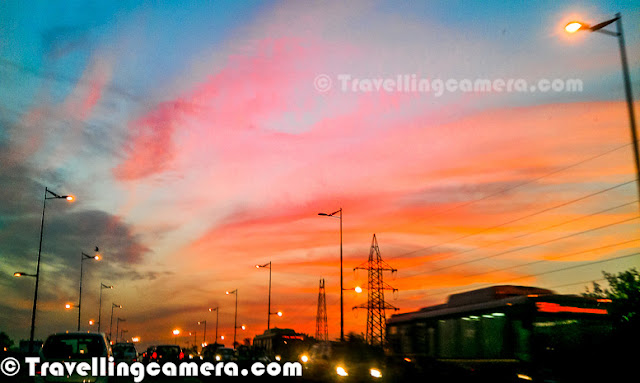During Wednesdays, I leave office by 5:00pm and go for a training in Delhi. All these photographs of sunset are shot with HTC DesireHD Camera during decemeber'12, when I was going through Delhi-Noida-Delhi Toll. It was one of the rare sunset view I saw in Delhi in last 8 years. Let's check out and enjoy these wonderful hues of nature.
Colors were looking more beautiful as we kept moving towards South Delhi.
Clear sky and subtle clouds makes the whole view more dramatic. This usually happens after some showers and no fog.
With time, it started getting dark and then I was missing my SLR camera. Usually Mobile-Cameras are enough but two factors were making it difficult to capture these moments well - Low light and moving car.
All these photographs are shot from moving car, so will also notice some shake in these photographs. We didn't have time to stop the car and enjoy this moments with more effective stills.
Scattering affects the hues of light coming through sky, but overall details are determined by the wavelength of the light and the size of the particles. The short-wavelength blue and violet are scattered in the air much more than other colors of the spectrum. This is why blue and violet light reaches our eyes from all directions on a clear day. But because we can't see violet very well, the sky appears blue.
Because the sun is low on the horizon, sunlight passes through more air at sunset and sunrise than during the day, when the sun is higher in the sky. More atmosphere means more particles to scatter the violet and blue light away from your eyes. If the path is long enough, all of the blue and violet light scatters out of your line of sight. The other colors continue on their way to your eyes. This is why sunsets are often yellow, orange, and red. Isn't it awesome.
Check out more related stuff at - http://www.sciencedaily.com/releases/2007/11/071108135522.htm
Duration sunset is defined in astronomy as the moment when the trailing edge of the Sun's disk disappears below the horizon in the west. The ray path of light from the setting Sun is highly distorted near the horizon because of atmospheric refraction, making the sunset appear to occur when the Sun’s disk is already about one diameter below the horizon. Sunset is distinct from dusk, which is the moment at which darkness falls, which occurs when the Sun is approximately eighteen degrees below the horizon. The period between sunset and dusk is called twilight.
Courtesy - http://en.wikipedia.org/wiki/Sunset
The time of sunset varies throughout the year and it's determined by the viewer's position on Earth, specified by longitude and latitude, and elevation. Small daily changes and noticeable semi-annual changes in the timing of sunsets are driven by the axial tilt of Earth, daily rotation of the Earth, the planet's movement in its annual elliptical orbit around the Sun, and the Earth and Moon's paired revolutions around each other. During winter and spring, the days get longer and sunsets occur later every day until the day of the latest sunset, which occurs after the summer solstice. In the Northern Hemisphere, the latest sunset occurs late in June or in early July, but not on the summer solstice of June 21.
Sunsets on other planets appear different because of the differences in the distance of the planet from the Sun, as well as different atmospheric compositions.
On Mars, the Sun appears only about two-thirds of the size that it appears in a sunset seen from Earth, because Mars is farther from the Sun than the Earth is. Although Mars lacks oxygen and nitrogen in the atmosphere, it is covered in red dust frequently hoisted into the atmosphere by fast but thin winds.


.jpg)
.jpg)
.jpg)
.jpg)
.jpg)
.jpg)
.jpg)
.jpg)
.jpg)


.jpg)
Comments